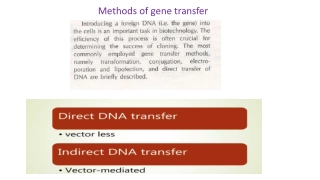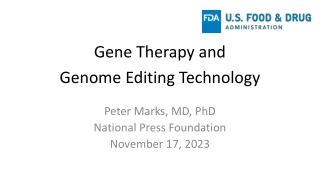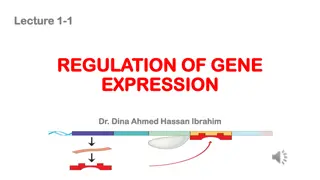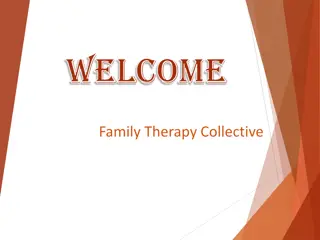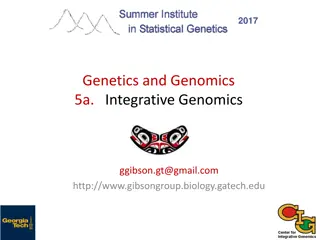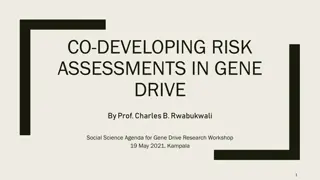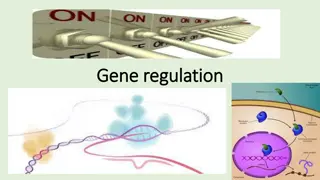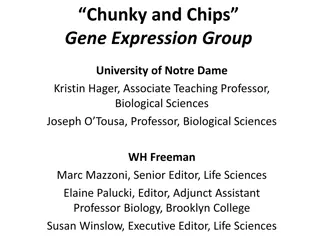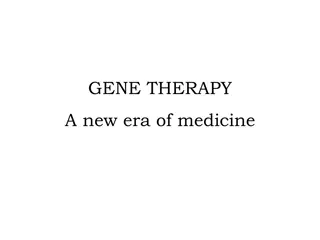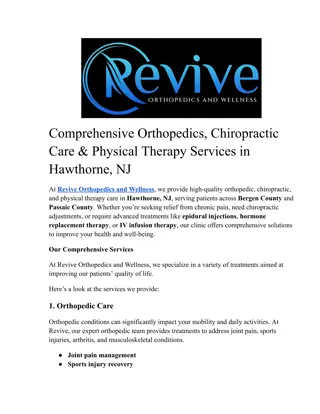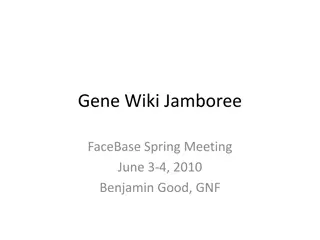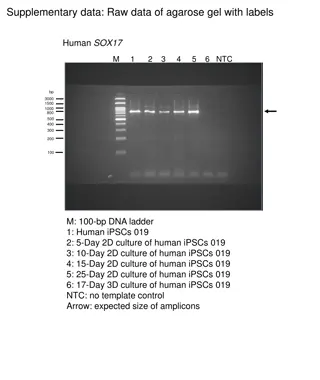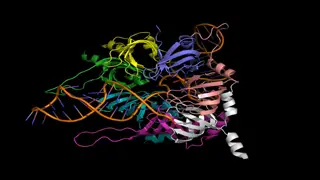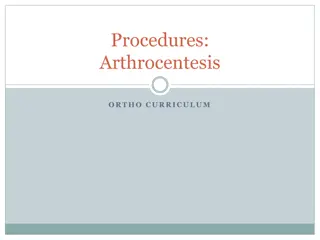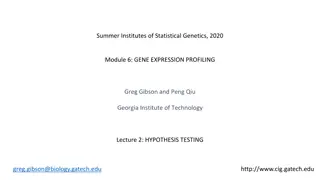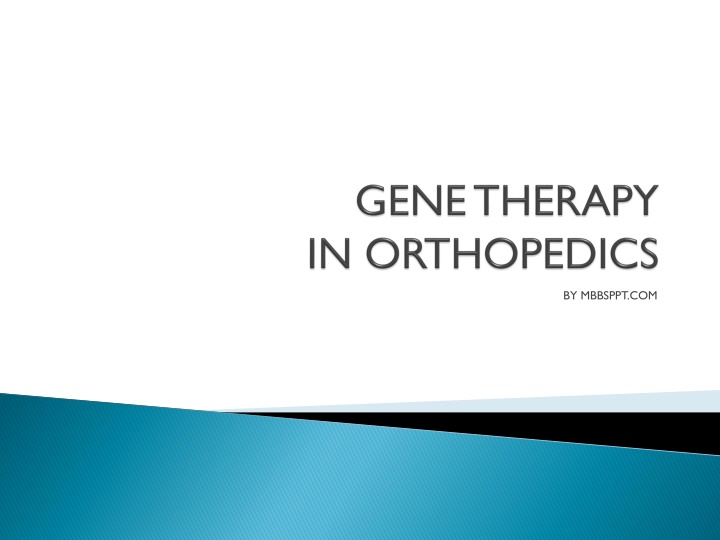
Innovations in Tissue Regeneration and Genetic Therapies
Explore the cutting-edge techniques and advancements in tissue healing and genetic therapies. From molecular biological analysis to elegant delivery methods, uncover the key factors influencing successful outcomes. Discover the role of growth factors, cytokines, and genetic interventions in optimizing tissue repair. Dive into the fascinating world of regenerative medicine and the future of curative treatments for various disorders.
Download Presentation

Please find below an Image/Link to download the presentation.
The content on the website is provided AS IS for your information and personal use only. It may not be sold, licensed, or shared on other websites without obtaining consent from the author. If you encounter any issues during the download, it is possible that the publisher has removed the file from their server.
You are allowed to download the files provided on this website for personal or commercial use, subject to the condition that they are used lawfully. All files are the property of their respective owners.
The content on the website is provided AS IS for your information and personal use only. It may not be sold, licensed, or shared on other websites without obtaining consent from the author.
E N D
Presentation Transcript
Mechanical stabilization & Biomechanical analysis Alone !!??? Biology of soft tissue and bone healing needed for good outcome and success. E.g.: RA dependent on action of growth factors, cytokines antigen presentations and protein interactions
OA molecular biological, immunological & biochemical aspects play key role Other disorders Osteogenesis imperfecta, DMD today s treatment only symptomatic Genetic defect and biological effect to be understood to provide a curative treatment
Elegant technique Sustained local delivery of therapeutic growth factors/cytokines using Viral/nonviral delivery vehicles (vectors) Genetic information cDNA encoding the protein of interest is inserted into living cell Potential to express the protein
Soft tissues Diff capacities to heal foll injuries Healing by formation of scar decreased mechanical stress than original tissues Genes for specific growth factors Introduced into injured tissue
Directly injected into tissue & inserts gene into surrounding cells Indirectly muscle/skin biopsy- cultured & vector introduced into cells Viral transduction Non viral-- transfection
Replication deficient retrovirus Adenovirus Adeno associated virus Herpes virus Lentivirus
Liposomes DNA-protein conjugates DNA-protein defective virus conjugates
Therapies that will replace, repair and promote tissue regeneration # healing involves many regenerative mechanisms. BMP -- key molecule
Impact of #-- Several members of BMP induced & activated Synth by callus forming cells near # site BMP Network Noggin Sonic hedgehog(shh) Hepatocyte growth factor(HGF) Vascular Endothelial Growth Factor(VEGF)
Major driving force for new treatment techniques Reduction of recovery time Least invasive
Current modalities Use of tissue graft, cell transplantations, artificial scaffolding. Short half life and inherent instability of proteins Requires high and multiple doses of proteins
Sustained release of biological agent at therapeutic levels By transfer of gene encoding the therapeutic agent to the cells of the afflicted tissue or By implanting cells that have been previously genetically modified
Accelerated and enhanced Musculoskeletal tissue (Bone, ligament, tendon, cartilage) regeneration Inhibit disease progression
Bone and soft tissue healing Degenerative(OA,RA,disc) Congenital (OI,DMD,ED) Tumors
Growth factors BMP Accelerate healing of segmental defects BMP-7-mediated ex vivo gene transfer based on Mesenchymal Stem Cells may accelerate callus formation in distraction osteogenesis and facilitate consolidation. Hu J - J Orthop Res - 01-FEB-2007; 25(2): 241-51
Delayed administration of adenoviral BMP-2 vector improves the formation of bone in osseous defects achieve radiological union, repair tissue with enhanced mineralization and greater mechanical strength Betz OB - Gene Ther - 01-JUL-2007; 14(13): 1039-44
Recombinant BMP-2 used for spinal fusion successfully in clinical trials Large dose needed for adequate bone repair Comparison of lentiviral and adenoviral gene therapy for spinal fusion in rats. Miyazaki M - Spine - 1-JUN-2008; 33(13): 1410-7
Reconstructed ACL grafts undergo remodelling; no regeneration With Gene Therapy Regenerate ACL from tendon graft
Use of rhBMP-2 or rhBMP-7 in an injectable calcium phosphate matrix in an intra-articular model of rabbit ACL reconstruction improved tendon-to-bone healing, based on histologic analysis and biomechanical testing. Clinics in Sports Medicine -Volume 26, Issue 4 (October 2007)
Adenovirus mediated Gene therapy with BMP-14 and BMP-12 increased tendon tensile strength in a rat model of Achilles tendon injury. Bolt P - J Bone Joint Surg Am - 01-JUN-2007; 89(6): 1315-20 Majewski M - Gene Ther - 01-AUG-2008; 15(16): 1139- 46
Construction of eukaryotic expression plasmid of bFGF gene in rats and its expression in tenocytes. increase in expression of type I and III collagen mRNA--repair of tendons and ligaments. Feng Y - J Huazhong Univ Sci Technolog Med Sci - 01- FEB-2007; 27(1): 27-30
Articular cartilage: Highly organised Avascular Low healing capacity Degeneration/loss of articular surface challenging problem
regulatory molecules that augment the reparative activities of the cells, inhibit the cells' degradative activities-- include insulin-like growth factor I, fibroblast growth factor 2, bone morphogenetic proteins 2, 4, and 7, and interleukin-1 receptor antagonist.
Gene transfer into articular cartilage and synovial lining cells protect existing cartilage and build new cartilage. Gene therapy for articular cartilage repair. Trippel S - Proc Inst Mech Eng [H] - 01-JUL-2007; 221(5): 451-9
Articular chondrocytes are receptive to transduction AAV vector mediated TGFbeta1-overexpression stimulates cartilage anabolism.
Studies Viral vectors used to transfer genes 1 and GFAT gene to increase the capacity of joint tissues to synthesize glucosamine. achieve long-term relief IL-1Ra, IGF-
Amelioration of osteoarthritis by intra-articular hyaluronan synthase 2 gene therapy. - Zhang DW - Med Hypotheses - 01-JAN-2007; 69(5): 1111-3
Attempts to block Primary inflammatory mediators-- IL-1 Redirection of primary immune cells like Th-1 and Th-2 lymphocytes
new targets for gene therapy in the intervertebral disc TGF-beta1, TIMP-1, and LMP-1 Gene therapy for the treatment of degenerative disk disease. Hubert MG - J Am Acad Orthop Surg - 01-JUN-2008; 16(6): 312-9
Nucleus pulposus cellular longevity by telomerase gene therapy. - Chung SA - Spine - 15-MAY-2007; 32(11): 1188-96 Telomerase can extend the cellular lifespan of nucleus pulposus cells prolong the production of extracellular matrix
The RANKL system therapeutic target in treatment of aseptic periprosthetic loosening. gene transfer using an AAV vector has protective effects against orthopaedic wear debris-induced bone loss.
Adenovirus-mediated transfer of siRNA against Runx2/Cbfa1 inhibits the formation of heterotopic ossification induced by BMP4 (in animal model.) Lin L - Biochem Biophys Res Commun - 20-OCT-2006; 349(2): 564-72
CONGENITAL mutations in cartilage oligomeric matrix protein (COMP), (synthesized by chondrocytes) causes two skeletal dysplasias: multiple epiphyseal dysplasia (MED/EDM1), pseudoachondroplasia (PSACH), a dwarfing condition
Detailed knowledge of pathology helpful in future treatment with gene therapy Expression of mutant cartilage oligomeric matrix protein in human chondrocytes induces the pseudoachondroplasia phenotype. Merritt TM - J Orthop Res - 01-APR-2006; 24(4): 700-7
Lentivirus mediated Heme Oxygenase-1 gene transfer enhances myogenic precursor cell survival after autologous transplantation in pig skeletal muscle. LaumonierT - Mol Ther - 01-FEB-2008; 16(2): 404-10
gene therapy may achieve induction of tumour necrosis and increased tumour sensitivity to chemotherapy
BMP-2 levels diminished after Perioperative radiation therapy in M/sk sarcoma Gene therapy to enhance allograft incorporation after host tissue irradiation. - Santoni BG - Clin Orthop Relat Res - 01-AUG-2008; 466(8): 1921-9
Attenuated Salmonella typhimurium with IL-2 gene reduces pulmonary metastases in murine osteosarcoma. - Sorenson BS - Clin Orthop Relat Res - 01-JUN-2008; 466(6): 1285-91
Pigment epithelium-derived factor overexpression inhibits orthotopic osteosarcoma growth, angiogenesis and metastasis. Done in rats and humans- promising approach Ek ET - Cancer Gene Ther - 01-JUL-2007; 14(7): 616- 26
Novel cytosine deaminase fusion gene enhances the effect of radiation on breast cancer in bone by reducing tumor burden, osteolysis, and skeletal fracture. - Goblirsch M - Clin Cancer Res - 15-MAY-2006; 12(10): 3168-76
Limited understanding of Biochemical properties & Molecular mechanisms of connective tissue Gene Therapy- one of the most advanced and exciting concepts For a better & less invasive treatment options

